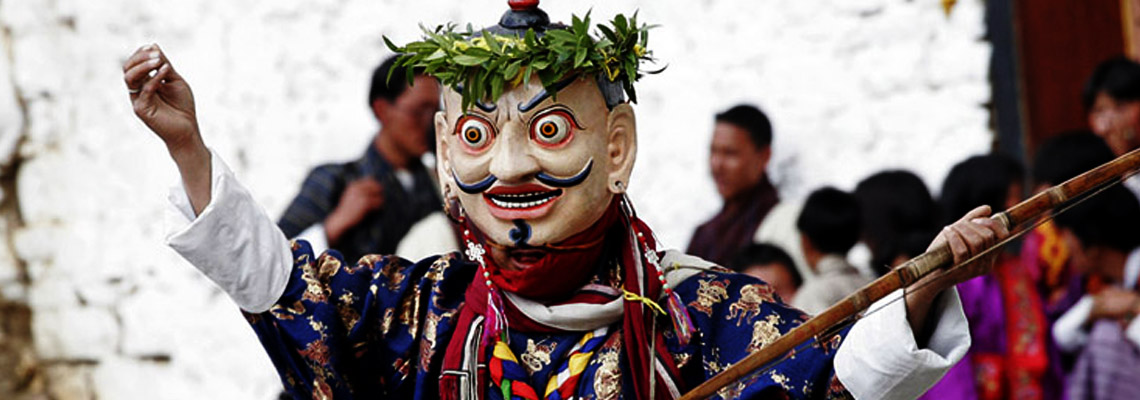
CULTURAL TOUR PACKAGES
Home / TOUR PACKAGES / CULTURAL TOUR PACKAGES
One of the biggest festivals in the country is the Thimphu Tshechu. This festival is held in the capital city for three days beginning on 10th day of the 8th month of lunar calendar. This Tshechu is witnessed by thousands of people many of which travel from neighboring Dzongkhags (districts) to attend the festivities. The actual Tshechu is preceded by days and nights of prayer and rituals to invoke the gods. When it was initiated by the 4th Desi, Gyalse Tenzin Rabgay in 1867 the Tshechu consisted of only a few dances being performed strictly by monks. These were the Zhana chham and the Zhana Nga chham (Dances of the 21 Black Hats), Durdag (Dance of the Lords of the Cremation Ground), and the Tungam chham (Dance of the Terrifying Deities). The Thimphu Tshechu underwent a change in the 1950s, when the third King Jigme Dorji Wangchuck, introduced numerous Boed chhams (mask dances performed by lay monks). These additions added colour and variation to the festival without compromising its spiritual significance. Mask dances like the Guru Tshengye (Eight Manifestations of Guru), Shaw Shachi (Dance of the Stags) are enjoyed because they are similar to stage-theater. Equally important are the Atsaras, who are more than just mere clowns. The Atsaras are the dupthobs (acharyas), who provide protection. The dances and the jesting of the Atsaras are believed to entrance evil forces and prevent them from causing harm during Tshechus. Modern Atsaras also perform short skits to disseminate health and social awareness messages. The festival celebrates the culture of the communities living in close proximity to endangered snow leopards. A community based initiative for the conservation of snow leopards. Jomolhari Mountain Festival is an exquisitely themed two-day event celebrated at the base of Mt. Jomolhari, by communities located along one of the most scenic trekking routes in Bhutan. The festival celebrates the culture of the communities living together with the natural wonders that surround them: one in particular, the elusive, yet elegant, snow leopard! This endangered cat thrives in the region; several camera trap photos and definite signs have established the region as one of the best snow leopard habitats in Bhutan. The communities of Soe Yaksa and Soe Yutoed, located along the Jomolhari trek, in collaboration with Jigme Dorji National Park (JDNP) and the Nature Recreation and Ecotourism Division (NRED) – with support from the Snow Leopard Conservancy (SLC) and Bhutan Foundation – bring together this festival as a community based initiative towards the conservation of snow leopard; to create awareness on the importance of conservation; engage and build on the perception and attitude to create harmony between this endangered cat and the people; provide a platform to bring in opportunities for sustainable livelihood, and promote their culture. Gomphu Kora lies in the heart of the agrarian belt of eastern Bhutan. It is 23 kilometres from Trashigang Dzong, the headquarters of Bhutansese most populous district, and two kilometers from Duksum, a quaint hamlet consisting of a few shops. Gomphu means Meditation Cavea and Kora means Circumambulation The name is derived from a cave formed out of a rock-face next to a temple that has been built as a tribute to this sacred site. The story of Gomphu Kora goes back to the 8th century AD. Legend has it that an evil spirit named Myongkhapa escaped from Samye in Tibet when Guru Padmasambhava, the progenitor of the Nyingma strand of Buddhism, was spreading the Dharma in the Himalayas. Myongkhapa followed the course of the present-day Kholongchhu stream and concealed himself inside a rock where Gomphu Kora stands today. The Guru followed the evil, mediated for three days inside the rock cave and finally vanquished it. Several prominent religious personalities have undertaken pilgrimage to Gomphu Kora and the earliest was Gongkhar Gyal, grandson of Lhasay Tsangma. He built a small shrine at Gomphu Kora around the 10th century A.D. In the 14th century, Terton Pema Lingpa, visited Gomphu Kora and enlarged the existing shrine. It was renovated and enlarged in the 15th century by Yongzin Ngagi Wangchuk, the grandfather of Zhabdrung Ngawang Namgyel. He also inscribed murals on the walls of the temple.THIMPHU TSHECHU
JOMOLHARI FESTIVAL
GOMPHU KORA FESTIVAL